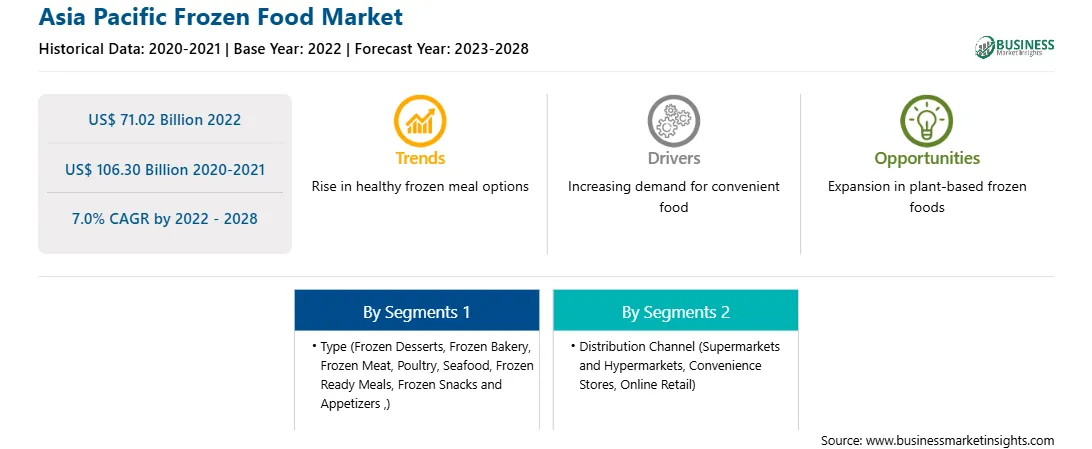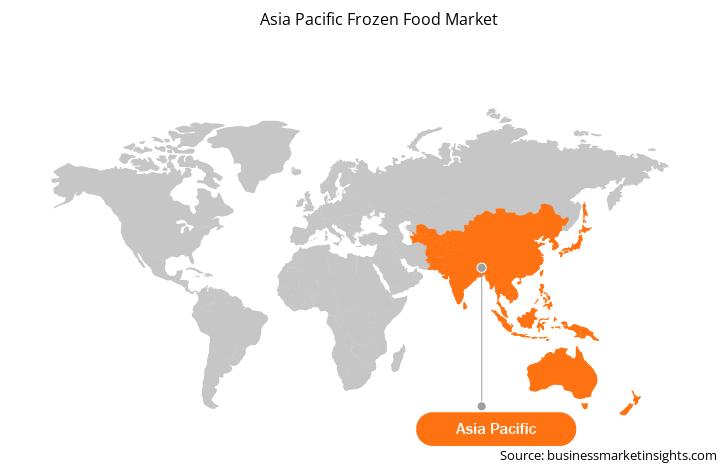The frozen food market in Asia Pacific is expected to grow from US$ 71.02 billion in 2022 to US$ 106.30 billion by 2028; it is estimated to grow at a CAGR of 7.0% from 2022 to 2028.
The growth of the Asia Pacific frozen food market is mainly attributed to strategic development initiatives by frozen food manufacturers in this region. They are making significant investments in product innovation with the aim of expanding their customer base and meeting emerging consumer trends. They are launching gluten-free, plant-based, sugar-free, organic, and clean-labeled products, as well as products suitable for a keto diet, which meet the varied requirements of consumers. In 2022, Prasuma, an Indian leading brand offering frozen food, launched frozen snack varieties, including frozen veg and chicken spring rolls, frozen chicken nuggets, chicken and veg mini samosas, chicken and mutton shami kebabs and seekh kebabs, along with bacon options. These products were launched to help consumers stay on track with their health goals while enjoying their meals. Such product innovations help companies extend their reach and gain a competitive edge in international markets.
Frozen food manufacturers are also adopting strategies such as business expansion and production capacity scaleup to better serve their customers. Some are also collaborating and partnering with other market players. These developments are creating lucrative growth opportunities in the frozen food market players.
Asia Pacific Frozen Food Market Revenue and Forecast to 2028 (US$ Billion)
Strategic insights for the Asia Pacific Frozen Food provides data-driven analysis of the industry landscape, including current trends, key players, and regional nuances. These insights offer actionable recommendations, enabling readers to differentiate themselves from competitors by identifying untapped segments or developing unique value propositions. Leveraging data analytics, these insights help industry players anticipate the market shifts, whether investors, manufacturers, or other stakeholders. A future-oriented perspective is essential, helping stakeholders anticipate market shifts and position themselves for long-term success in this dynamic region. Ultimately, effective strategic insights empower readers to make informed decisions that drive profitability and achieve their business objectives within the market. The geographic scope of the Asia Pacific Frozen Food refers to the specific areas in which a business operates and competes. Understanding local distinctions, such as diverse consumer preferences (e.g., demand for specific plug types or battery backup durations), varying economic conditions, and regulatory environments, is crucial for tailoring strategies to specific markets. Businesses can expand their reach by identifying underserved areas or adapting their offerings to meet local demands. A clear market focus allows for more effective resource allocation, targeted marketing campaigns, and better positioning against local competitors, ultimately driving growth in those targeted areas.Asia Pacific Frozen Food Strategic Insights

Asia Pacific Frozen Food Report Scope
Report Attribute
Details
Market size in 2022
US$ 71.02 Billion
Market Size by 2028
US$ 106.30 Billion
Global CAGR (2022 - 2028)
7.0%
Historical Data
2020-2021
Forecast period
2023-2028
Segments Covered
By Type
By Distribution Channel
Regions and Countries Covered
Asia-Pacific
Market leaders and key company profiles
Asia Pacific Frozen Food Regional Insights

Asia Pacific Frozen Food Market Segmentation
The Asia Pacific frozen food market is segmented on the basis of type, distribution channel, and country. Based on type, the market is segmented into frozen desserts; frozen bakery; frozen meat, poultry, and seafood; frozen ready meals; frozen snacks and appetizers; and others. The meat, poultry, and seafood segment is expected to hold the largest market share during the forecast period. Based on distribution, the Asia Pacific frozen food market is segmented into supermarkets and hypermarkets, convenience stores, online retail, and others. The online retail segment is projected to register the highest CAGR in the market due convenience associated with online buying and product delivery options. Based on country, the Asia Pacific frozen food market is segmented into Australia, China, India, Japan, South Korea, and the Rest of Asia Pacific. The Rest of Asia Pacific held the largest market share in 2022.
Bellisio Foods, Inc.; Bonduelle Group; General Mills; Kellogg’s Company; McCain Foods Limited; Nestle S.A.; The Kraft Heinz Company; and Tyson Foods, Inc. are among the leading companies in the frozen food market in the region.
The Asia Pacific Frozen Food Market is valued at US$ 71.02 Billion in 2022, it is projected to reach US$ 106.30 Billion by 2028.
As per our report Asia Pacific Frozen Food Market, the market size is valued at US$ 71.02 Billion in 2022, projecting it to reach US$ 106.30 Billion by 2028. This translates to a CAGR of approximately 7.0% during the forecast period.
The Asia Pacific Frozen Food Market report typically cover these key segments-
The historic period, base year, and forecast period can vary slightly depending on the specific market research report. However, for the Asia Pacific Frozen Food Market report:
The Asia Pacific Frozen Food Market is populated by several key players, each contributing to its growth and innovation. Some of the major players include:
The Asia Pacific Frozen Food Market report is valuable for diverse stakeholders, including:
Essentially, anyone involved in or considering involvement in the Asia Pacific Frozen Food Market value chain can benefit from the information contained in a comprehensive market report.